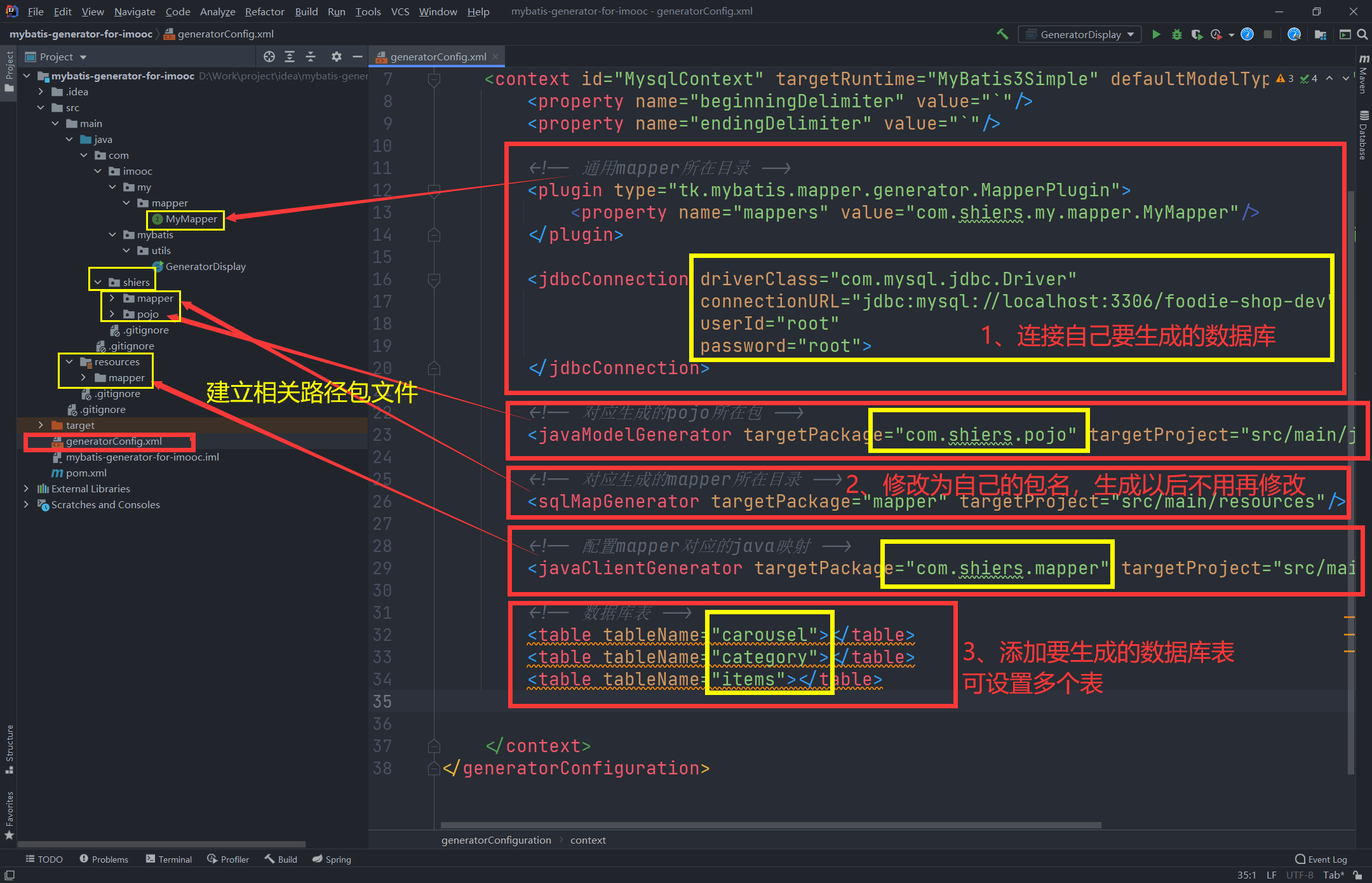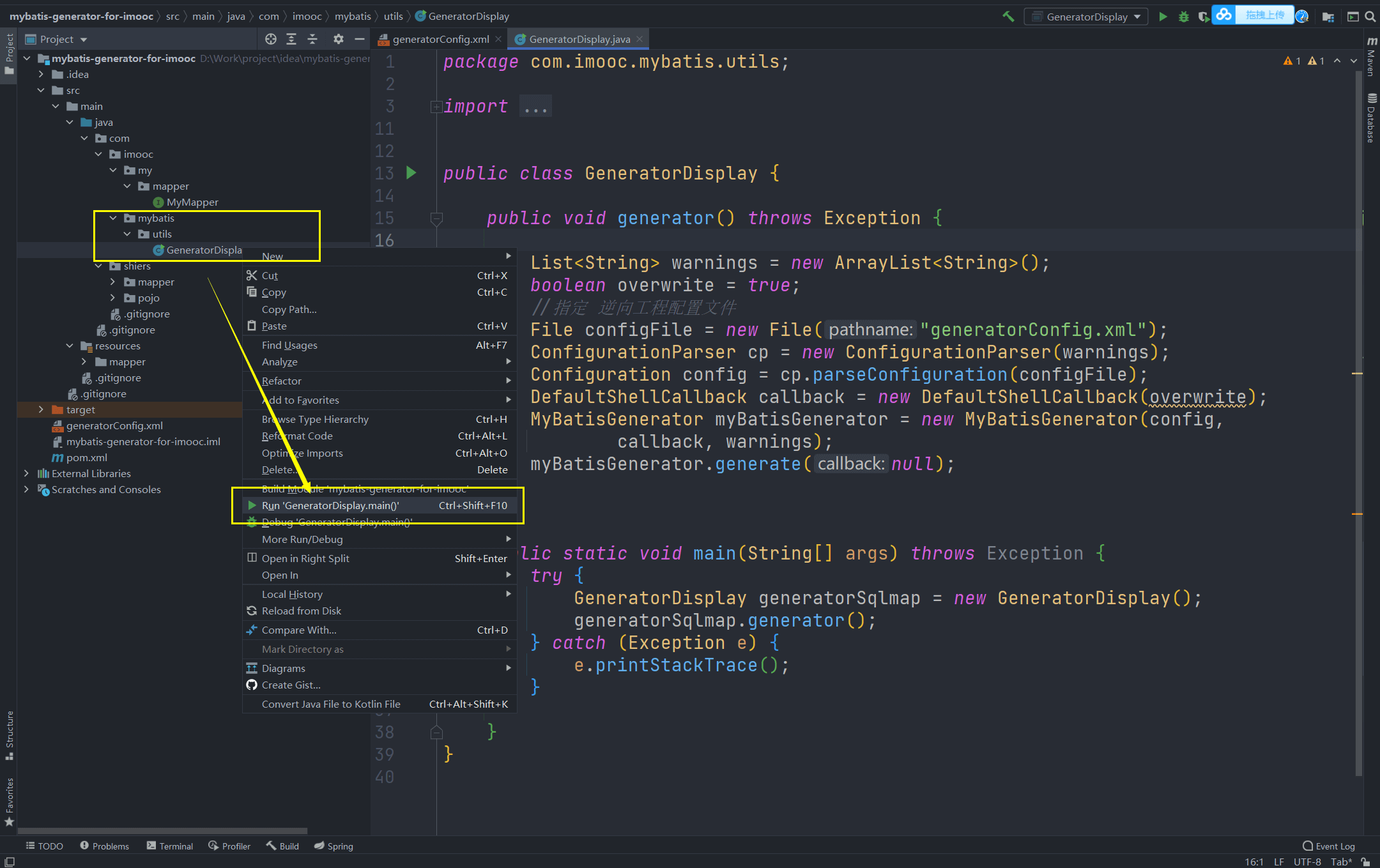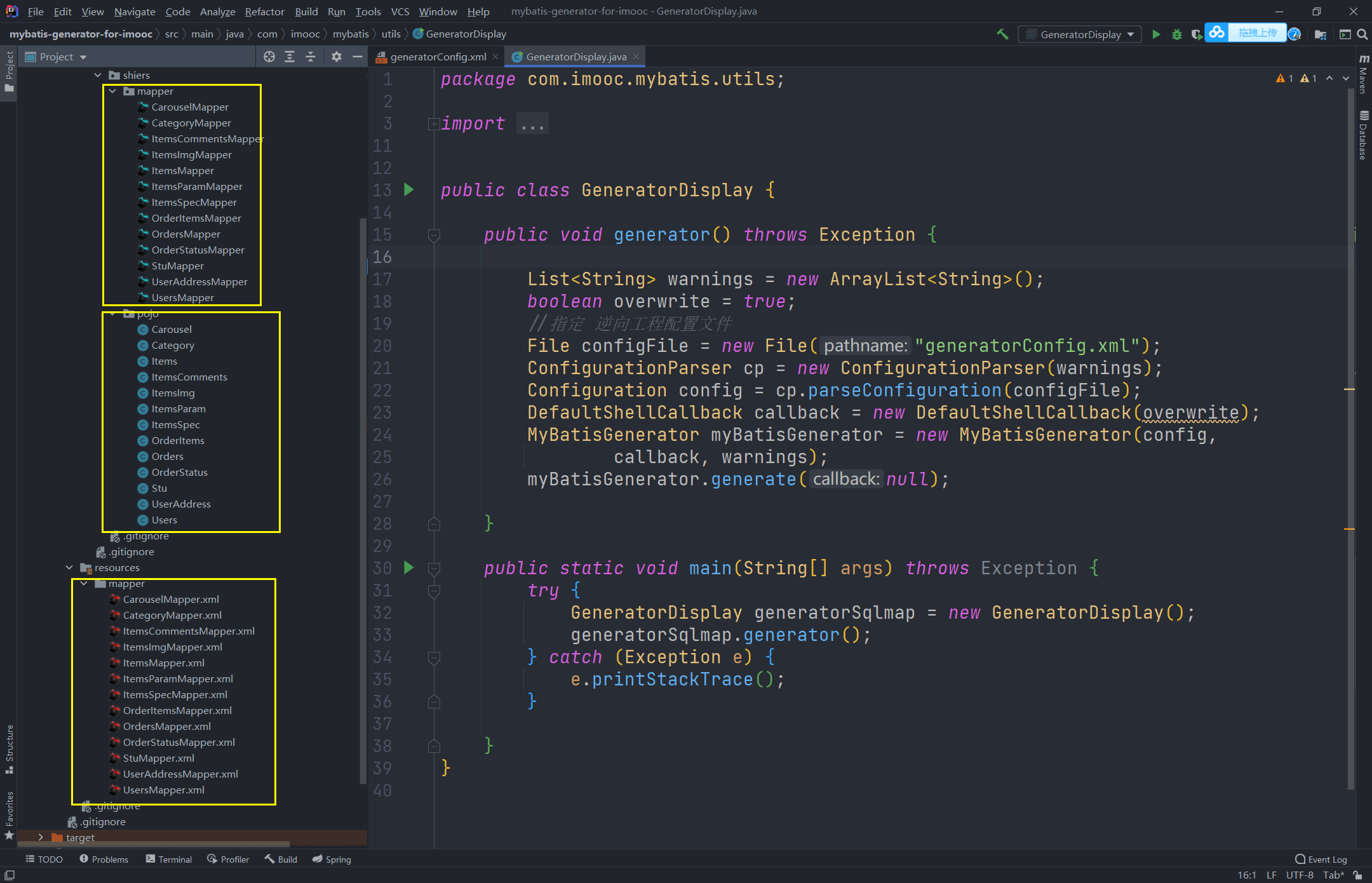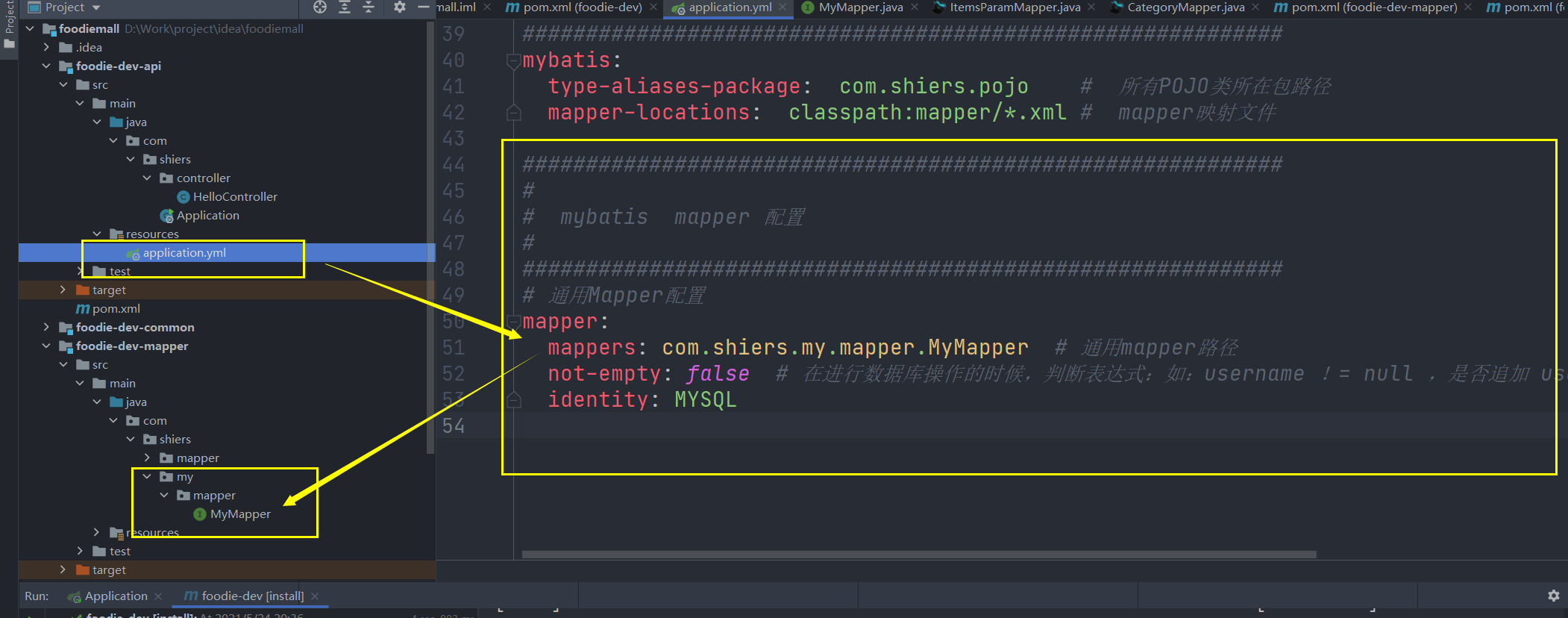mybatis-generator-for-imooc.zip
生成
1、配置
2、运行项目生成文件
3、完成生成
4、拷贝到我们自己的项目中
1)、导入pom.xml依赖
<!--通用mapper逆向工具--><dependency><groupId>tk.mybatis</groupId><artifactId>mapper-spring-boot-starter</artifactId><version>2.1.5</version></dependency>
2)、注意:需要要引入MyMapper
生成的Mapper需要依赖MyMapper
package com.shiers.my.mapper;import tk.mybatis.mapper.common.Mapper;import tk.mybatis.mapper.common.MySqlMapper;/*** 继承自己的MyMapper*/public interface MyMapper<T> extends Mapper<T>, MySqlMapper<T> {}
3)、复制生成的文件到我们自己项目相应位置
4)、添加配置项
############################################################## mybatis mapper 配置############################################################## 通用Mapper配置mapper:mappers: com.shiers.my.mapper.MyMapper # 通用mapper路径not-empty: false # 在进行数据库操作的时候,判断表达式:如:username != null ,是否追加 username != ''identity: MYSQL
5、🔥在启动类配置包扫描路径!!!🔥
使用
public boolean queryUsernameIsExist(String username) {//使用Example条件进行查询//创建查询对象对应的Example映射Example userExample = new Example(Users.class);Example.Criteria userCriteria = userExample.createCriteria();//构建查询条件userCriteria.andEqualTo("username",username);//通过Example查询usersMapper.selectOneByExample(userExample);return users == null ? false : true;}
基础接口
Select
接口:SelectMapper
方法:List
说明:根据实体中的属性值进行查询,查询条件使用等号
接口:SelectByPrimaryKeyMapper
方法:T selectByPrimaryKey(Object key);
说明:根据主键字段进行查询,方法参数必须包含完整的主键属性,查询条件使用等号
接口:SelectAllMapper
方法:List
说明:查询全部结果,select(null)方法能达到同样的效果
接口:SelectOneMapper
方法:T selectOne(T record);
说明:根据实体中的属性进行查询,只能有一个返回值,有多个结果是抛出异常,查询条件使用等号
接口:SelectCountMapper
方法:int selectCount(T record);
说明:根据实体中的属性查询总数,查询条件使用等号
接口:SelectByExampleMapper
方法:List
说明:根据Example条件进行查询
重点:这个查询支持通过Example类指定查询列,通过selectProperties方法指定查询列
接口:SelectCountByExampleMapper
方法:int selectCountByExample(Object example);
说明:根据Example条件进行查询总数
Insert
接口:InsertMapper
方法:int insert(T record);
说明:保存一个实体,null的属性也会保存,不会使用数据库默认值
接口:InsertSelectiveMapper
方法:int insertSelective(T record);
说明:保存一个实体,null的属性不会保存,会使用数据库默认值
Update
接口:UpdateByPrimaryKeyMapper
方法:int updateByPrimaryKey(T record);
说明:根据主键更新实体全部字段,null值会被更新
接口:UpdateByPrimaryKeySelectiveMapper
方法:int updateByPrimaryKeySelective(T record);
说明:根据主键更新属性不为null的值
接口:UpdateByExampleMapper
方法:int updateByExample(@Param(“record”) T record, @Param(“example”) Object example);
说明:根据Example条件更新实体record包含的全部属性,null值会被更新
接口:UpdateByExampleSelectiveMapper
方法:int updateByExampleSelective(@Param(“record”) T record, @Param(“example”) Object example);
说明:根据Example条件更新实体record包含的不是null的属性值
Delete
接口:DeleteMapper
方法:int delete(T record);
说明:根据实体属性作为条件进行删除,查询条件使用等号
接口:DeleteByPrimaryKeyMapper
方法:int deleteByPrimaryKey(Object key);
说明:根据主键字段进行删除,方法参数必须包含完整的主键属性
接口:DeleteByExampleMapper
方法:int deleteByExample(Object example);
说明:根据Example条件删除数据
base 组合接口
接口:BaseSelectMapper
方法:包含上面Select的4个方法
接口:BaseInsertMapper
方法:包含上面Insert的2个方法
接口:BaseUpdateMapper
方法:包含上面Update的2个方法
接口:BaseDeleteMapper
方法:包含上面Delete的2个方法
CRUD 组合接口
接口:BaseMapper
方法:继承了base组合接口中的4个组合接口,包含完整的CRUD方法
Example 方法
接口:SelectByExampleMapper
方法:List
说明:根据Example条件进行查询
重点:这个查询支持通过Example类指定查询列,通过selectProperties方法指定查询列
接口:SelectCountByExampleMapper
方法:int selectCountByExample(Object example);
说明:根据Example条件进行查询总数
接口:UpdateByExampleMapper
方法:int updateByExample(@Param(“record”) T record, @Param(“example”) Object example);
说明:根据Example条件更新实体record包含的全部属性,null值会被更新
接口:UpdateByExampleSelectiveMapper
方法:int updateByExampleSelective(@Param(“record”) T record, @Param(“example”) Object example);
说明:根据Example条件更新实体record包含的不是null的属性值
接口:DeleteByExampleMapper
方法:int deleteByExample(Object example);
说明:根据Example条件删除数据
Example 组合接口
接口:ExampleMapper
方法:包含上面Example中的5个方法
Condition 方法
Condition方法和Example方法作用完全一样,只是为了避免Example带来的歧义,提供的的Condition方法
接口:SelectByConditionMapper
方法:List
说明:根据Condition条件进行查询
接口:SelectCountByConditionMapper
方法:int selectCountByCondition(Object condition);
说明:根据Condition条件进行查询总数
接口:UpdateByConditionMapper
方法:int updateByCondition(@Param(“record”) T record, @Param(“example”) Object condition);
说明:根据Condition条件更新实体record包含的全部属性,null值会被更新
接口:UpdateByConditionSelectiveMapper
方法:int updateByConditionSelective(@Param(“record”) T record, @Param(“example”) Object condition);
说明:根据Condition条件更新实体record包含的不是null的属性值
接口:DeleteByConditionMapper
方法:int deleteByCondition(Object condition);
说明:根据Condition条件删除数据
Condition 组合接口
接口:ConditionMapper
方法:包含上面Condition中的5个方法
RowBounds
默认为内存分页,可以配合PageHelper实现物理分页
接口:SelectRowBoundsMapper
方法:List
说明:根据实体属性和RowBounds进行分页查询
接口:SelectByExampleRowBoundsMapper
方法:List
说明:根据example条件和RowBounds进行分页查询
接口:SelectByConditionRowBoundsMapper
方法:List
说明:根据example条件和RowBounds进行分页查询,该方法和selectByExampleAndRowBounds完全一样,只是名字改成了Condition
RowBounds 组合接口
接口:RowBoundsMapper
方法:包含上面RowBounds中的前两个方法,不包含selectByConditionAndRowBounds
special 特殊接口
这些接口针对部分数据库设计,不是所有数据库都支持
接口:InsertListMapper
方法:int insertList(List
说明:批量插入,支持批量插入的数据库可以使用,例如MySQL,H2等,另外该接口限制实体包含id属性并且必须为自增列
接口:InsertUseGeneratedKeysMapper
方法:int insertUseGeneratedKeys(T record);
说明:插入数据,限制为实体包含id属性并且必须为自增列,实体配置的主键策略无效
MySQL 专用
接口:MySqlMapper
继承方法:int insertList(List
继承方法:int insertUseGeneratedKeys(T record);
说明:该接口不包含方法,继承了special中的InsertListMapper
SqlServer 专用
由于sqlserver中插入自增主键时,不能使用null插入,不能在insert语句中出现id。
注意SqlServer的两个特有插入方法都使用了
@Options(useGeneratedKeys = true, keyProperty = “id”)
这就要求表的主键为id,且为自增,如果主键不叫id可以看高级教程中的解决方法。
另外这俩方法和base中的插入方法重名,不能同时存在!
如果某种数据库和SqlServer这里类似,也可以使用这些接口(需要先测试)。
接口:InsertMapper
方法:int insert(T record);
说明:插入数据库,null值也会插入,不会使用列的默认值
接口:InsertSelectiveMapper
方法:int insertSelective(T record);
说明:插入数据库,null的属性不会保存,会使用数据库默认值
接口:SqlServerMapper
说明:这是上面两个接口的组合接口。
Ids 接口
通过操作ids字符串进行操作,ids 如 “1,2,3” 这种形式的字符串,这个方法要求实体类中有且只有一个带有@Id注解的字段,否则会抛出异常。
接口:SelectByIdsMapper
方法:List
说明:根据主键字符串进行查询,类中只有存在一个带有@Id注解的字段
接口:DeleteByIdsMapper
方法:int deleteByIds(String ids)
说明:根据主键字符串进行删除,类中只有存在一个带有@Id注解的字段
Ids 组合接口
接口:IdsMapper
方法:包含上面Ids中的前两个方法
Mapper 接口
接口:Mapper
该接口兼容Mapper2.x版本,继承了BaseMapper







